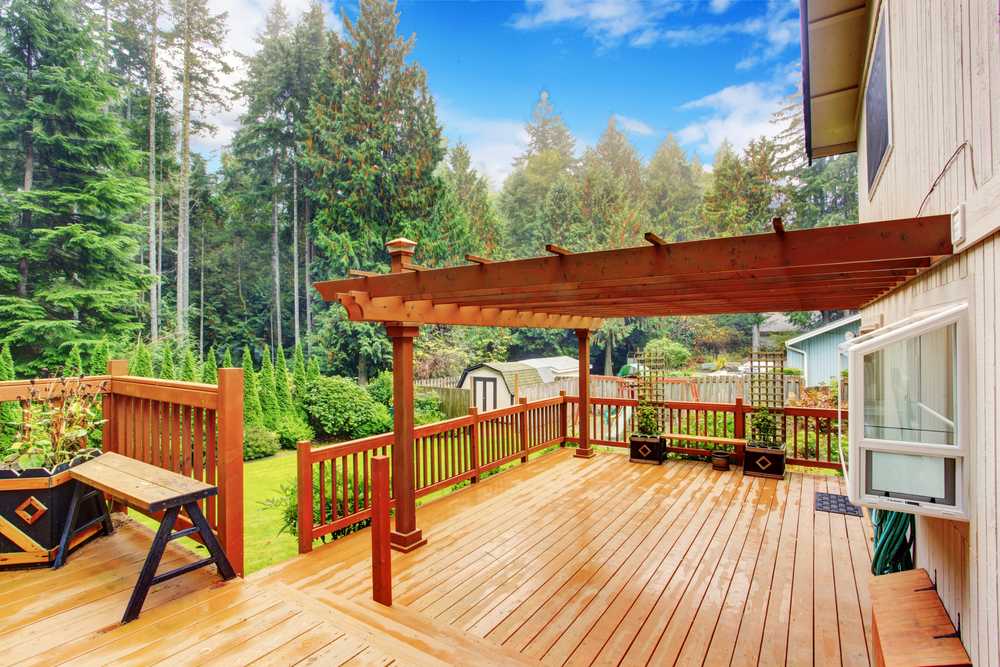It’s so nice to do indoor things outdoors. Serving dinner on the patio, for example, can lend a whole new batch of novelty to that old, standby custom of eating food in the evening.
If the temperature is just right and there’s no threat of precipitation, the idea of a patio covering probably won’t even cross your mind. If it’s so hot that you think sincerely about dropping ice cubes into the salad, however, some sort of shade might be helpful.
Likewise, if the rains come from the skies and drop their own moisture products onto your head, salad, shoulders, knees, and/or toes, a more specific (i.e. closed and waterproof) patio covering may be in order.
Read on to learn about some of your patio options and what they entail.
How to Attach a Patio Roof to an Existing House
Honestly, there is no easy technique for how to attach a patio roof to an existing house. It’s not really one of those home-improvement jobs that tend to work well as DIY projects. In a sense, you’re sort of building half the frame of a smaller house, against your house. It’s a medium carpentry job with a large side of roofing.
Investing in the required suite of power tools alone–cordless drill, circular saw, nail gun and the like–will eat into the savings you get from doing the work yourself. You also may need permits–frankly, you probably will. Contractors work with permits every day and know what to look for, who to talk to, and what’s needed. An independent homeowner who’s not familiar with the process, however, stands a good chance of missing a permit that they need, and cities don’t like to cut they-didn’t-know slack for that.
There are plenty of articles and YouTube videos online that provide a good introduction to the basics of how to attach a patio roof to your house (assuming the requisite permits have been secured). Take a look at them; if it looks similar enough to other carpentry projects you’ve done in the past, feel free to give it a try. If you have any hesitation or second-guess your skills, call experienced Denver roofers to help.
Attached Patio Roof vs. Free Standing Patio Cover
A freestanding patio cover is still a big project, but it’s usually easier to build than a patio roof that attaches to your house. In general, retrofitting anything onto anything brings up problems. Whenever possible, it’s pretty much always better to put new things onto other new things.
And so, if any significant portion of your patio’s square footage is at least a few yards away from your house, a freestanding patio cover will probably be your best bet, at least when it comes to construction. Maybe when it comes to using it, too–there’s a certain feeling of luxury that comes up when you walk from the domain of inside your home to the outdoors and then into another protected, not to mention beautiful, area which is still outdoors.
In fact, a freestanding patio cover affords virtually unlimited style options. By contrast, a patio roof attached to your house depends largely on what’s going on with your siding and existing roof. This is true both in terms of technicals (the eaves question, for example) and style. Whereas any freestanding patio cover can look natural away from the house, one that grows directly out of the side of the house but deviates from the house’s color scheme, shingle and siding style can look strange and awkward.
Other Patio Covering Options
Of course, there are a great many types of patio coverings–both attached and detached–to choose from. As mentioned above, much of the decision depends on what you’d like your patio covering to block. Sun, heat, precipitation, or all three?
Many of the patio covering types have fun names, too. A pergola is a freestanding structure that provides “filtered shade” but little to no protection from rain and snow. They’re perfect in dry, hot climates. Alternatively, it’s possible to build in a retractable, soft-roof system.
Gazebos are freestanding octagons with closed roofs and open sides. You see them in public places a lot, but rarely in people’s backyards. This lends an element of novelty to them, making them especially visually interesting additions to a grander patio scheme.
Ramadas aren’t hotels. The hotel chain picked a great structure to name itself after, though. A ramada is basically a pergola with a closed roof. There’s just something so nice–downright magical if you’re in the right mood–about serving a meal or hosting a gathering outdoors, even (especially?) when it’s raining. Ramadas, with their closed roofs, make this an intrinsic option. The closed roof both protects attendees from the rain and traps in heat.
Wrapping Up
There is no easy answer for how to attach a patio roof to an existing house. That’s the type of project that people become professionals for. It’s a great addition to your house, though, and can make your backyard a much more hospitable environment to relax in.
One notch lower on the difficulty continuum than the attached patio roof is the freestanding patio cover. It’s always easier to build new things when you don’t have to worry about fitting them onto whatever system is already present.
Also, there are many styles of patio covering, a few of which we have discussed above. It all depends on how you want to use your patio covering, what you like to look at, and what’s already going on on that end of your property.
Give us a call today to talk about how to attach a patio roof to your house–or just how to attach one to your property. With Colorado’s best home improvement company on the case, anything is possible!


